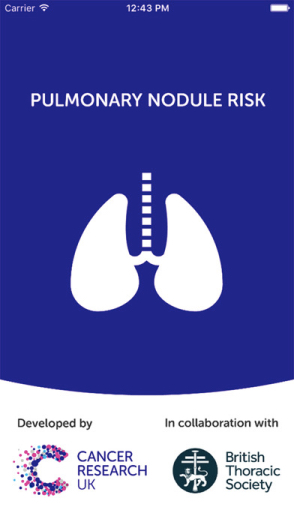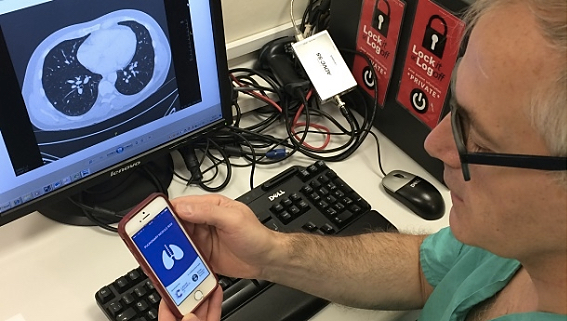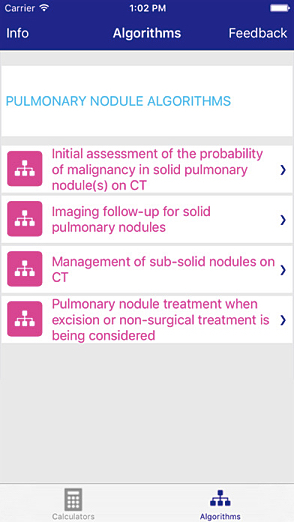 Cancer Research UK has launched a new smartphone app designed to help doctors determine the next steps for patients in whom small tissue masses, known as pulmonary nodules, have been detected in the lungs.
Cancer Research UK has launched a new smartphone app designed to help doctors determine the next steps for patients in whom small tissue masses, known as pulmonary nodules, have been detected in the lungs.
These masses appear as round white shadows in chest X-ray or CT scan images. While most of these nodules, which are common, turn out to be harmless, some can develop into malignancies that require treatment.
 In collaboration with the British Thoracic Society (BTS), Cancer Research UK tasked their in-house experts to develop a free app for Apple iOS mobile devices. Key features of this app, called Pulmonary Nodule Risk, include the Brock and Herder risk prediction and volume doubling time (VDT) calculators, which are recommended by BTS to assist clinicians in the diagnosis and treatment of pulmonary nodules, and the BTS guidelines for investigation and management of lung nodules.
In collaboration with the British Thoracic Society (BTS), Cancer Research UK tasked their in-house experts to develop a free app for Apple iOS mobile devices. Key features of this app, called Pulmonary Nodule Risk, include the Brock and Herder risk prediction and volume doubling time (VDT) calculators, which are recommended by BTS to assist clinicians in the diagnosis and treatment of pulmonary nodules, and the BTS guidelines for investigation and management of lung nodules.
The Pulmonary Nodule Risk app, which requires Apple iOS 8.1 or later and is compatible with Apple iPhone, iPad, and iPod touch, is designed for use by doctors, nurses and technicians examining people with pulmonary nodules, and summarizes key parts of the four management algorithms that appear in the full BTS guideline document, turning the mobile device into a powerful aid to accurately manage nodules.
The calculators and management algorithms are engineered to be used in conjunction with the full BTS Guidelines published in 2015 (Thorax 70, Supplement 2).
Currently, respiratory clinicians and radiologists use CT scans and data from patient records to help determine the best management of patients who have lung nodules.
The Pulmonary Nodule Risk app puts additional information in the clinician’s hand to quickly and accurately assess patients at risk and in need of additional tests to confirm a lung cancer diagnosis. The app offers additional patient information without conducting unnecessary tests and causing needless worry for people whose nodules are likely to be benign, and it enables clinicians to proceed quickly with appropriate treatment or discharge the patient.

Cancer Research UK says it worked with more than 40 doctors, radiologists and nurses across the country, seeking advice and feedback on the app’s design to ensure it is straightforward, reliable, and delivers the right advice with quick and simple solutions to support critical decision-making. Also instrumental to the smartphone app’s development were former co-chairs of the BTS Guideline Group for the Investigation and Management of Pulmonary Nodules.
 “Mobile phones have become essential tools in most people’s everyday lives. Moving beyond selfies, social media and playlists, this app is designed to support clinicians in their decision-making so we can help ensure the right people are getting the right tests at the right time,” Cancer Research UK’s head of early diagnosis Dr. Jodie Moffat said in a press release.
“Mobile phones have become essential tools in most people’s everyday lives. Moving beyond selfies, social media and playlists, this app is designed to support clinicians in their decision-making so we can help ensure the right people are getting the right tests at the right time,” Cancer Research UK’s head of early diagnosis Dr. Jodie Moffat said in a press release.
“Using smartphones to put this knowledge into clinicians’ hands will enable them make the best possible choices more quickly and efficiently, helping to speed up the time it takes to diagnose lung cancer,” she added. “Ensuring that patients who need further tests get these quickly is another step toward diagnosing lung cancer as swiftly as possible.”
Cancer Research UK notes that an online version of the calculator has been used more than 18,700 times so far this year.
 “The new app is a very useful tool for healthcare professionals to help guide their assessment, diagnosis and treatment of pulmonary nodules, ensuring that management is evidence based,” said Prof. David Baldwin, consultant respiratory physician at Nottingham University Hospitals and a member of the British Thoracic Society.
“The new app is a very useful tool for healthcare professionals to help guide their assessment, diagnosis and treatment of pulmonary nodules, ensuring that management is evidence based,” said Prof. David Baldwin, consultant respiratory physician at Nottingham University Hospitals and a member of the British Thoracic Society.
“It builds on the existing and very popular BTS Pulmonary Nodule Risk Prediction Calculator and we’re delighted to have partnered with Cancer Research UK to develop the app so that it will make the guideline so much more accessible via the [Apple] App Store,” he said. “It means that many more practitioners will be able to access the essential elements of the guideline on the go, and in different settings within the hospital.”
The app is currently only available for Apple iOS devices. The development team says it will monitor demand to determine whether Android or Windows cellphone versions are needed.

